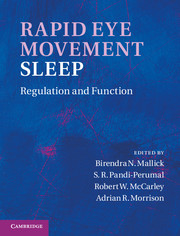Book contents
- Frontmatter
- Contents
- Contributors
- Preface
- Acknowledgments
- Organization
- Section I Historical context
- Section II General biology
- Section III Neuronal regulation
- Section IV Neuroanatomy and neurochemistry
- 19 Aminergic influences in the regulation of basic REM sleep processes
- 20 REM sleep regulation by cholinergic neurons: highlights from 1999 to 2009
- 21 GABAergic modulation of REM sleep
- 22 Glutamatergic regulation of REM sleep
- 23 The role of tuberomammillary nucleus histaminergic neurons, and of their receptors, in the regulation of sleep and waking
- 24 Hypocretinergic system: role in REM-sleep regulation
- 25 Neuropeptides and REM sleep
- 26 Adenosine and glycine in REM-sleep regulation
- 27 Changes in neurotransmitter levels in relation to REM sleep for its regulation
- 28 Pontine areas inhibiting REM sleep
- 29 Neuronal models of REM-sleep control: evolving concepts
- Section V Functional significance
- Section VI Disturbance in the REM sleep-generating mechanism
- Index
- Plate section
- References
21 - GABAergic modulation of REM sleep
from Section IV - Neuroanatomy and neurochemistry
Published online by Cambridge University Press: 07 September 2011
- Frontmatter
- Contents
- Contributors
- Preface
- Acknowledgments
- Organization
- Section I Historical context
- Section II General biology
- Section III Neuronal regulation
- Section IV Neuroanatomy and neurochemistry
- 19 Aminergic influences in the regulation of basic REM sleep processes
- 20 REM sleep regulation by cholinergic neurons: highlights from 1999 to 2009
- 21 GABAergic modulation of REM sleep
- 22 Glutamatergic regulation of REM sleep
- 23 The role of tuberomammillary nucleus histaminergic neurons, and of their receptors, in the regulation of sleep and waking
- 24 Hypocretinergic system: role in REM-sleep regulation
- 25 Neuropeptides and REM sleep
- 26 Adenosine and glycine in REM-sleep regulation
- 27 Changes in neurotransmitter levels in relation to REM sleep for its regulation
- 28 Pontine areas inhibiting REM sleep
- 29 Neuronal models of REM-sleep control: evolving concepts
- Section V Functional significance
- Section VI Disturbance in the REM sleep-generating mechanism
- Index
- Plate section
- References
Summary
Summary
Gamma-aminobutyric acid (GABA) is the main inhibitory neurotransmitter in the adult mammalian brain. GABA receptors are ubiquitous and are highly expressed in many brain areas modulating states of sleep and wakefulness. The consistent finding that drugs that enhance GABAergic transmission also enhance sleep supports the conclusion that endogenous GABA promotes sleep. The effects of GABA on sleep, however, vary as a function of brain region. GABAergic transmission in the pontine reticular formation, the tuberomammillary region of the posterior hypothalamus, and the ventrolateral part of the periaqueductal gray has been shown to promote wakefulness, non-rapid eye movement (NREM) sleep, or rapid eye movement (REM) sleep, respectively. The finding that hypothalamic GABA-containing neurons project to the dorsal raphe nucleus, locus coeruleus, and pontine reticular formation encourages future studies aiming to determine the extent to which these GABAergic neurons play a causal role in the generation and maintenance of REM sleep. Functional neuroanatomical studies have identified neural pathways that contribute to REM-sleep generation. Simultaneous, in vivo single-cell recordings of identified GABAergic neurons combined with direct measures of endogenous GABA offer a productive approach for gaining future insights.
- Type
- Chapter
- Information
- Rapid Eye Movement SleepRegulation and Function, pp. 206 - 213Publisher: Cambridge University PressPrint publication year: 2011
References
- 1
- Cited by



